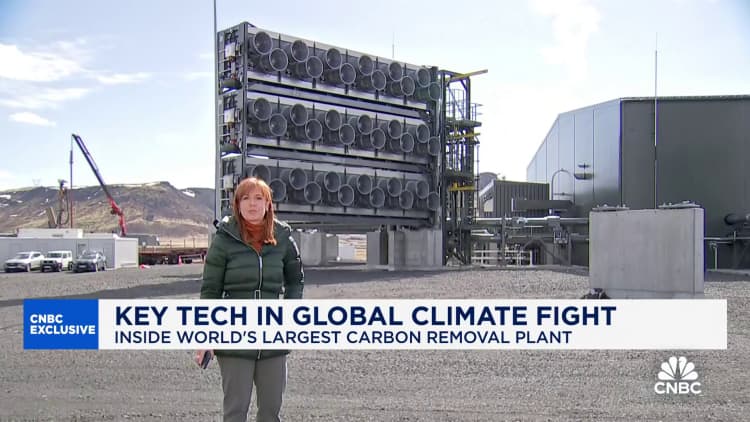
Wind turbines in Dawson, Texas, on February 28, 2023.
Mark Felix | Afp | Getty Images
As carbon emissions from fossil fuels continue to warm the planet, environmentally conscious consumers may be wondering if there is a way to purchase electricity from renewable sources without installing technology like solar panels or windmills on their property.
In short, the answer is yes.
However, this option is not necessarily available to all homeowners and renters. According to experts, it often comes with a slight price premium.
Few people know that they can buy green energy
According to the US Energy Information Administration, renewable energy sources – including wind, solar, hydroelectric, geothermal and biomass – accounted for about 21% of US electricity generation in 2023.
The majority or 60% of energy sources came from fossil fuels such as coal, natural gas and oil. These energy sources release carbon dioxide, a greenhouse gas that traps heat in the atmosphere and contributes to global warming.
The White House is aiming for electricity generation to be free of greenhouse gas emissions by 2035.
More individuals and organizations are choosing to transition away from fossil fuels: According to the National Renewable Energy Laboratory, in 2022, approximately 9.6 million customers purchased 273 terawatt hours of renewable energy through voluntary green energy markets. This is a fivefold increase compared to 54 TWh in 2012.
In the voluntary market, customers purchase renewable energy from utilities in quantities above federal minimum requirements. More than half of all U.S. states have policies in place to increase the share of renewable energy in electricity supplies, although most goals are still years away.
According to the Environmental Protection Agency, voluntary purchases accounted for 28% of the renewable energy market (excluding hydroelectric power) in 2016. They help increase overall demand for renewable electricity, driving changes in the energy mix, according to the EPA.
Photovoltaic solar panels at the Roadrunner Solar Power Plant near McCamey, Texas, on November 10, 2023.
Jordan Vonderhaar/Bloomberg via Getty Images
The NREL estimates that businesses account for most of the increase. Home sales have also increased, but at a slower pace.
Only one in six U.S. adults know that they may have the option to purchase renewable electricity either from their utility or another provider, according to the most recent NREL survey data on the topic released in 2011.
“The market is growing every year in terms of sales and customers,” said Jenny Sumner, group leader for modeling and analysis at NREL.
“But very few people know that they can choose green programs,” she said. “That’s just not the most important thing for most people.”
How consumers can buy green electricity
Joe Raedle | Getty Images News | Getty Images
Wind turbines in Solano County, California, on August 28, 2023.
Loren Elliott/Bloomberg via Getty Images
Energy suppliers may offer so-called green pricing programs.
According to the U.S. Department of Energy, in these programs, also known as utility green energy programs, customers pay their utility a “small premium” to purchase electricity from renewable sources.
The cost generally exceeds the cost of standard power from a utility by about 1 to 2 cents per kilowatt-hour, Sumner said.
That could mean about $5 to $15 more per month, Sumner said. Ultimately, it will depend on factors such as the program price and household energy consumption, she added.
According to a 2019 survey by Yale University’s Program on Climate Change Communication, nearly half of Americans, 47%, said they would be willing to pay more to get 100% of their electricity from renewable sources. On average, they said they would be willing to pay $33.72 more per month.
Marketing programs for green energy
In some states, consumers can also opt into green energy marketing programs.
Such states have “competitive” energy markets, meaning consumers can choose between many different companies to produce electricity. But unlike green pricing programs, the company that generates the renewable electricity may not be the customer’s utility that distributes the electricity.
According to the U.S. Department of Energy and EPA, residential green energy options are available in these states with competitive or deregulated markets: California, Connecticut, Delaware, Illinois, Maine, Maryland, Massachusetts, Michigan, New Hampshire, New Jersey, New York , Ohio, Pennsylvania, Rhode Island, Texas and Virginia.
These also typically come with a premium, although in some regions they “may be priced competitively compared to standard electricity options,” the agencies wrote.
Aggregation of community choices
With community choice aggregation programs, local governments purchase electricity on behalf of their residents from an alternative green energy supplier.
The township essentially acts as a supplier of the township’s electricity, Sumner said. These programs are particularly common in California, she said.
Unlike the other program types, residents are generally not required to opt into community choice programs. This typically happens automatically and consumers can opt out if necessary, Sumner said.
This is how renewable energy certificates work
A solar farm in Imperial, California, on December 6, 2023.
Valerie Macon | Afp | Getty Images
Just because a consumer chooses renewable electricity does not mean that the electricity pumped into their home comes from those renewable sources.
This may sound strange, but it has to do with the physical nature of electricity and its movement through the shared electrical grid.
“Once the electrons are injected into the grid, there is no way to label that they are ‘green’ electrons and that they are not green,” said Joydeep Mitra, head of the energy systems program at Michigan State University. “Nobody knows which electrons go where.”
Green energy programs instead rely on “renewable energy certificates,” or RECs.
The certificates are essentially a billing mechanism for the production and purchase of renewable energy, Mitra said.
You may not get green electricity, but somewhere there is. And RECs keep track.
Every consumer, even if they do not have access to a green energy program through their energy supplier, can also purchase a REC as a separate, stand-alone product. It’s a way to provide additional funding for a renewable energy project that would typically be sold by a broker or marketer rather than a utility, Sumner said.
Purchasing these certificates separately has no impact on a consumer’s existing supply relationship.
This way you can ensure that your electricity is environmentally friendly
Experts recommend choosing a green energy option or a REC that has been verified by an independent third party.
That’s because voluntary sales and purchases of renewable energy are not subject to government oversight, according to the EPA and the U.S. Department of Energy.
One such independent entity is the Center for Resource Solutions, a nonprofit organization that oversees the Green-e certification standard, the agencies said.
For example, Green-e monitors the disclosures that utilities make to consumers about renewable energy and, among other things, ensures that purchases of that energy do not count toward federal energy targets.
In this new series, CNBC examines what climate change means for your money, from retirement savings to insurance costs to career prospects.
Has climate change left you with bigger or new bills? Tell us about your experience by sending me an email at gregory.iacurci@nbcuni.com.
Source link
2024-05-21 19:24:17
www.cnbc.com














